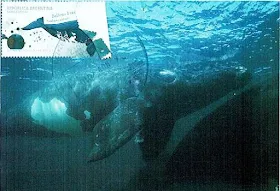This is the repaired version, after I have re-glued the right side of the stamp. Notice the vertical wear mark to the right of the denomination 75, and the big (but faint) vertical wear mark (white) in the middle of the postcard.
This is the original version, as I received in the mail, with the right side of the stamp unglued, torn and folded. Luckily, the Automated Postal Systems from United States Postal Service (USPS) and from Correos de Argentina were not that brutal, this time, as to completely destroy or remove the stamp.
Notice the tear and wear marks over my ZIP code 20170, and in the lower right corner.
This is the repaired version, where I re-glued the paper as much as possible. Now the ZIP code is visible.
Why this project?
I saw that stamp with The Southern Right Whale (Balaenoptera australis), on a previous cover from Viviana (thank you, again! :) ) and I wanted to create a maximum card.
Since she did not find a regular, commercial postcard in Argentina, I decided to create one.
I cut out an image from a book, and I affixed a self-adhesive, peelable paper backing (notice the symbol in the lower right corner of the above image).
I have sent to my friend that custom postcard, and I asked her to affix the matching stamp on the picture side, and the rest of the necessary stamps on the address side.
Of course that I could have asked her to send it under cover (not undercover, like a secret :) ).
But I wanted to expose that non-traditional maximum card/maxicard/dorincard to the harsh reality and brutality of the Postal Systems.
My unique-in-the-world, UNICATE/UNICAT postal and philatelic item has really traveled in the mail, without protective cover, and it has the battle scars to prove it.
That's what I expected - no surprise.
Lessons re-learned about how to prepare a postcard, custom or not
1 - Don't affix the stamp just with saliva or water, if it's not self-adhesive. Especially if the stamp is on the glossy picture side. It may fall off, as I had cases from Norway, Luxemburg, etc.
Glue the stamp thoroughly and carefully. Make it stick.
2 - Affix the stamps (especially those on the rough-paper address side) a little away from the right margin of the postcard. That's where the Postal Machines will start tearing while processing them.
3 - Write the address (especially the apartment numbers, postal codes, etc.) also a little away from the right margin of the postcard. Don't ask me why - I just told you. :)
4 - If you are the sender, and your address and text are confidential - tell your recipient, so they don't upload and publicize that info.
In this case here, Viviana's address is already available on her blog, so http://www.zazzle.com/according_to_my_calculations_the_problem_doesnt_postage-172223422425144979?rf=238693463283865848
==========================================================
"They are called "right whales" because whalers thought the whales were the "right" ones to hunt, as they float when killed and often swim within sight of shore. As such, they were nearly hunted to extinction during the active years of the whaling industry. Today, instead of hunting them, people often watch these acrobatic animals for pleasure."
"The southern right whale (Eubalaena australis) is a baleen whale, one of three species classified as right whales belonging to the genus Eubalaena. Like other right whales, the southern right whale is readily distinguished from others by the callosities on its head, a broad back without a dorsal fin, and a long arching mouth that begins above the eye. Its skin is very dark grey or black, occasionally with some white patches on the belly. The right whale's callosities appear white due to large colonies of cyamids (whale lice) [MY NOTE: not human lice - head or pubic]. It is almost indistinguishable from the closely related North Atlantic and the North Pacific right whales, displaying only minor skull differences."
Like a non-drunken sailor:
"One behavior unique to the southern right whale, known as sailing, is that of using their elevated flukes to catch the wind. It appears to be a form of play and is commonly seen off the coast of Argentina and South Africa.[3]".
And you thought that "the 400 pounds gorilla" is a huge thing...What is almost as heavy as 3 whole gorillas?
"The maximum size of an adult female is 18.5 m (61 ft)[citation needed] and can weigh up to 80 tonnes (79 LT; 88 ST).[citation needed] The testicles of right whales are likely to be the largest of any animal, each weighing around 500 kg (1,100 lb). This suggests that sperm competition is important in the mating process.[5] Its penis is 12 feet long.[6]
Right whales cannot cross the warm equatorial waters to connect with the other (sub)species and (inter)breed: their thick layers of insulating blubber make it impossible for them to dissipate their internal body heat in tropical waters."
See, too much blubber may be hazardous to your romantic life...




No comments:
Post a Comment
My cyberguests: thank you for taking time and mental energy to leave a comment!
Your ongoing feedback is always appreciated.
If you never return, it is my fault for boring (?) you.
If you return, it is your merit to have discovered a blog worth exploring and following. :)